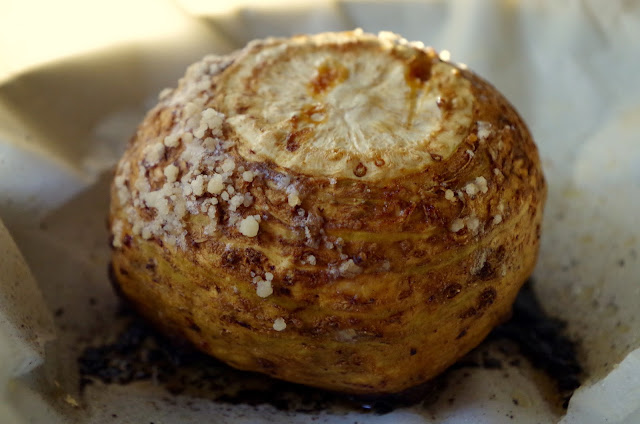Rosemary Cake
I have waxed poetic about it before, and certainly my affection for this book has not changed. It is not a traditional cookbook; instead, it is a meandering lyric on Adler's relationship to food. Her basic premise, as hinted at in her title, is that all food begets more food. Our meals should be everlasting. Those beets you just roasted? Their greens would go great on that pizza that you just made with the sourdough starter you have tucked in a corner of your refrigerator. Those beans you made? Their broth is the base for the minestrone of leftover pasta from last night. Did you just make a roasted chicken? Better keep the bones to toss into a pot to make the perfect chicken broth.
Tucked among her thoughts on the meaning of food are simple, sweet recipes. This particular recipe does not come from page 215 (the "Pork shoulder braised in milk with garlic, sage and lemon" is far too similar to the pork from Marcella that I made at the end of 2013) so I went to the next recipe of page 222. Indeed, it is reminiscent of the Semolina cake from Ottolenghi that I made last year, but this one is more savory, more grounded (and more wheat-based).
In a chapter on the end of things--in other words desserts--Adler thinks about why she has a fondenss for those end-of-meal morsels. Earlier in the book, she says that if we consider it carefully, no one really comes to our homes for the food. Instead they come for the company. And thus, when the dinner is consumed and "the night's slope tilt[s]" toward the end, "what seemed like it would last forever now seems certain to be nearly done." Dessert, then, is a way to linger just a little longer among that company we so wish to keep.
See? Food is not just food for her.

And, thus, it should not be for us either.
To start this year, my dear friend came for lunch. I heated up a chicken and wild rice soup that I had tucked in my freezer, and I whipped together this rosemary cake. Truly, this is a very easy cake to make, and provided that you have a neighbor with a rosemary bush two doors down from your house, you can make this cake with ingredients you already have. Coupled with unsweetened whipped cream, this cake seemed perfect for an early January lunch when you have a friend on her way over.

It was a perfect way to mark the beginning of a new year.
And I sent her home with half a loaf of cake, for Adler promises, "[t]omorrow, warmed in an oven, a slice of this cake, spread with jam, makes a consummate breakfast." So it has for me, and hopefully for her, this week.
What savory, everlasting joy.
To start this year, my dear friend came for lunch. I heated up a chicken and wild rice soup that I had tucked in my freezer, and I whipped together this rosemary cake. Truly, this is a very easy cake to make, and provided that you have a neighbor with a rosemary bush two doors down from your house, you can make this cake with ingredients you already have. Coupled with unsweetened whipped cream, this cake seemed perfect for an early January lunch when you have a friend on her way over.

My friend and I ate together at the kitchen table with the remnants of New Year's Eve flowers that are slowly dying in a vase at the table. Two cats prowled around, sometimes jumping up (admittedly) onto the table in order to peer out the window. We ate cake, but then even more sweetly, we moved to the living room to sit on the couch where we could talk about love, its beginnings, some of its endings, and our sweet memories of it.
And I sent her home with half a loaf of cake, for Adler promises, "[t]omorrow, warmed in an oven, a slice of this cake, spread with jam, makes a consummate breakfast." So it has for me, and hopefully for her, this week.
What savory, everlasting joy.
-------------
Rosemary Cake
Adapted from The Everlasting Meal
Yield:
2 bread pan cakes
Ingredients:
8 eggs
1 1/2 cups raw sugar
1 2/3 cups olive oil
4 Tbsp finely chopped rosemary
3 cups flour
2 Tbsp baking powder
1 tsp kosher salt
Instructions:
1. Preheat the oven to 325 degrees.
2. Coat 2 bundt pans or 2 loaf pans first with butter, then with flour, tapping out the excess flour.
3. Beat the eggs for 30 seconds with a handheld beater. Slowly add the sugar an continue to beat until the mixture is very foamy and pale. Still mixing, slowly drizzle in the olive oil. Using a spatula, fold in the rosemary.
4. In a separate bowl, whisk together the flour, baking powder, and salt. Keeping the mixer on low speed, gradually add the dry ingredients to the egg mixture. Pour the batter into the bundt pan or the loaf pan (about 2/3 of the way to the top, for the cake will rise).
5. Bake for 45-50 minutes; rotating the pan halfway through. The cake is done when it is golden brown and springs back when touched, or when a skewer is inserted in the center and comes out clean.Allow the cake to cool briefly in the pan and then tip it out onto a rack to continue cooking.
6. This is delicious on its own, or accompanied by freshly whipped unsweetened cream or Italian mascarpone.
7. Leftovers can be sliced, warmed in the oven, and spread with jam for breakfast.








Comments
Post a Comment